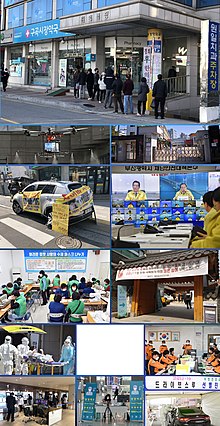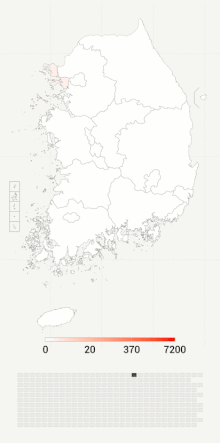
Back جائحة فيروس كورونا في كوريا الجنوبية Arabic Распаўсюджванне COVID-19 у Рэспубліцы Карэя Byelorussian দক্ষিণ কোরিয়ায় কোভিড-১৯ এর বৈশ্বিক মহামারী Bengali/Bangla پەتای جیھانیی کۆڤید-١٩ لە کۆریای باشور CKB Pandemie covidu-19 v Jižní Koreji Czech COVID-19-Pandemie in Südkorea German Πανδημία COVID-19 στη Νότια Κορέα Greek Pandemia de COVID-19 en Corea del Sur Spanish Koroonapandeemia Lõuna-Koreas Estonian دنیاگیری کووید-۱۹ در کره جنوبی Persian
| COVID-19 pandemic in South Korea | |
|---|---|
 From top to bottom then from left to right: a queue in front of a pharmacy in Wonju for the distribution of masks, a drone of disinfection in Seongnam, a closed elementary school in Daegu, protest inscriptions against Shincheonji on a car, video call between members of the South Korean government, manufacturing of masks in Busan, 2020 South Korean legislative election, admission of a symptomatic patient to a hospital in Busan, portable medical negative pressure isolation stretcher in a fire station in Hoengseong County, firefighters' training in Daegu, thermal camera at the entrance to Wonju hospital, temperature check at Incheon International Airport, drive-through testing in Gyeongju. | |
 Map of special cities & municipals with confirmed or suspected coronavirus cases (as of 5 March 2022): Confirmed 1~9,999 Confirmed 10,000~99,999 Confirmed ≥100,000 | |
 Coronavirus pandemic in South Korea over time (since 20 January 2020). Day not included in map Day included in map Last day included in map | |
| Disease | COVID-19 |
| Virus strain | SARS-CoV-2 |
| Location | South Korea |
| First outbreak | Wuhan, Hubei, China |
| Index case | Incheon International Airport |
| Arrival date | 20 January 2020 (5 years and 3 days) |
| Confirmed cases | 34,571,873[1] |
| Severe cases | 1,073[2] |
Deaths | 35,934[1] |
| Fatality rate | 0.1% |
| Vaccinations | |
| Government website | |
| ncov | |
| ||
|---|---|---|
|
Media gallery |
||
The COVID-19 pandemic in South Korea is part of the worldwide pandemic of coronavirus disease 2019 (COVID-19) caused by severe acute respiratory syndrome coronavirus 2 (SARS-CoV-2). The first case in South Korea was announced on 20 January 2020.[3] The number of confirmed cases increased on 19 February by 20, and on 20 February by 58[4] or 70,[5] giving a total of 346 confirmed cases on 21 February 2020, according to the Korea Disease Control and Prevention Agency (KDCA), with the sudden jump mostly attributed to "Patient 31" who participated in a gathering at a Shincheonji Church of Jesus the Temple of the Tabernacle of the Testimony church in Daegu.[5][6]
Amidst fears of further contamination, mass gatherings in the affected cities were cancelled and about 300 soldiers in Daegu were placed in isolation.[7][8] On 4 February 2020, in order to help prevent spread of the disease, South Korea began denying entry to foreigners traveling from Hubei Province in China.[9][10]
South Korea introduced what was considered one of the largest and best-organised epidemic control programs in the world, along with Singapore, Taiwan, and Vietnam.[11][12][13] Various measures have been taken to mass test the population for the virus, and isolate any infected people as well as trace and quarantine those they had contact with, without any further lockdown.[14][15] The rapid and extensive testing undertaken by South Korea has been judged successful in limiting the spread of the outbreak, without using the drastic measure of locking down entire cities.[14][16][17] Despite these successful measures, however, a significant rise in the number of new infections has occurred beginning in August 2020, with clusters being linked to Protestant churches in the Seoul Metropolitan Area.[18][19] Another rise began in the third week of November, and Seoul has since entered a third wave of infections.[20] On 24 November, the government raised the social distancing level in Seoul to level 2.[21] On 29 November, the social distancing level in other areas of the country was raised to 1.5.[22] In December, it was raised to level 2.5 in some metropolitan areas and 2 in other areas.[23]
In early 2022, there was a major spike in cases related to the Omicron variant, with 170 thousand cases reported on February 22.[24] South Korea began relaxing social distancing rules on 4 March 2022, and announced a shift toward endemic living on 18 March.[25][26][27] It lifted its vaccine mandate and quarantine requirement for fully vaccinated travelers on 1 April.[28][29] The number of new daily reported cases peaked at 621,317 on 16 March 2022, and the number of daily deaths peaked at 432 on 29 March 2022.[30]
- ^ a b c d e Mathieu, Edouard; Ritchie, Hannah; Rodés-Guirao, Lucas; Appel, Cameron; Giattino, Charlie; Hasell, Joe; Macdonald, Bobbie; Dattani, Saloni; Beltekian, Diana; Ortiz-Ospina, Esteban; Roser, Max (2020–2024). "Coronavirus Pandemic (COVID-19)". Our World in Data. Retrieved 21 January 2025.
- ^ "Coronavirus (COVID-19), Republic of Korea" (in Korean). Ministry of Health and Welfare. Retrieved 4 January 2022.
- ^ 신종 코로나바이러스 한국인 첫환자 확인. MK (in Korean). 서진우. 24 January 2020. Archived from the original on 24 January 2020. Retrieved 24 January 2020.
- ^ 31번 환자 연관 신천지교회 대남병원서 확진자 58명, 1명 사망. 20 February 2020. Archived from the original on 26 February 2020. Retrieved 21 February 2020.
- ^ a b Shin, Hyonhee; Cha, Sangmi (20 February 2020). "'Like a zombie apocalypse': Residents on edge as coronavirus cases surge in South Korea". Thomson Reuters. Archived from the original on 20 February 2020. Retrieved 20 February 2020.
- ^ "Coronavirus: South Korea reports 161 new cases, bringing total to 763; 7th death reported". The Straits Times. 24 February 2020. Archived from the original on 24 February 2020. Retrieved 24 February 2020.
- ^ "Seoul city to ban rallies, Shincheonji church services to curb virus". YNA. 21 February 2020. Archived from the original on 21 February 2020. Retrieved 21 February 2020.
- ^ "Soldiers in Daegu areas banned from leaving bases, meeting visitors". YNA. 21 February 2020. Archived from the original on 21 February 2020. Retrieved 21 February 2020.
- ^ Park, Rosyn (4 February 2020). "S. Korea Bars Foreigners Traveling from Hubei Province". Seoul: TBS. Archived from the original on 9 March 2020. Retrieved 15 August 2020.
- ^ "As Virus Spreads, Koreans Blame Refusal to Stop Chinese Visitors". Bloomberg. 28 February 2020. Retrieved 6 April 2020.
- ^ "Coronavirus Lessons from Singapore, Taiwan and Hong Kong". Archived from the original on 24 March 2020. Retrieved 24 March 2020.
- ^ "Why is Singapore's COVID-19 death rate the world's lowest". Archived from the original on 3 October 2020. Retrieved 17 September 2020.
- ^ "Taiwan Has Been Shut Out of Global Health Discussions". Archived from the original on 23 March 2020. Retrieved 24 March 2020.
- ^ a b Normile, Dennis (17 March 2020). "Coronavirus cases have dropped sharply in South Korea. What's the secret to its success?". Science. doi:10.1126/science.abb7566. S2CID 216427938. Archived from the original on 20 March 2020. Retrieved 20 March 2020.
- ^ Bicker, Laura (12 March 2020). "Coronavirus in South Korea: How 'trace, test and treat' may be saving lives". BBC News. Archived from the original on 20 March 2020. Retrieved 20 March 2020.
- ^ Kasulis, Kelly (19 March 2020). "South Korea's coronavirus lessons: Quick, easy tests; monitoring". Al Jazeera. Archived from the original on 20 March 2020. Retrieved 20 March 2020.
- ^ Dudden, Alexis; Marks, Andrew (20 March 2020). "South Korea took rapid, intrusive measures against Covid-19 – and they worked". The Guardian. Archived from the original on 20 March 2020. Retrieved 20 March 2020.
- ^ "South Korea on brink of nationwide virus outbreak, officials warn". BBC News. 24 August 2020. Retrieved 26 August 2020.
- ^ "South Korea Warns of 'Massive' Coronavirus Risk". Bloomberg News. 23 August 2020. Retrieved 26 August 2020.
- ^ "Third wave of COVID-19 infections arrived in Greater Seoul: authorities". 20 November 2020. Retrieved 29 November 2020.
- ^ "코로나바이러스감염증-19 중앙재난안전대책본부 정례브리핑" (in Korean). Central Disaster Management Headquarters, Central Disease Control Headquarters.
- ^ "전국 1.5단계 격상·부산 등 5곳 2단계 추진…수도권은 2단계+α(종합)" (in Korean). Yonhap News Agency. 29 November 2020.
- ^ "사회적 거리두기 단계 현황". Retrieved 10 January 2021.
- ^ "COVID Live". Worldometers. Retrieved 24 February 2022.
- ^ Woo-hyun, Shim (4 March 2022). "S. Korea eases social distancing rules as daily cases hit fresh high of 266,853". The Korea Herald. Retrieved 10 April 2022.
- ^ "Commentary: Why is South Korea easing restrictions when COVID-19 cases are at an all-time high?". CNA. Retrieved 10 April 2022.
- ^ "South Korea relaxes some pandemic restrictions, even as COVID-19 cases hover at record levels". Stars and Stripes. Retrieved 10 April 2022.
- ^ Schulz, Bailey. "South Korea to allow fully vaccinated travelers to visit without a quarantine period". USA Today. Retrieved 10 April 2022.
- ^ Shin, Hyonhee (1 April 2022). "S.Korea likely to lift outdoor mask mandate, most COVID curbs this month". Reuters. Retrieved 10 April 2022.
- ^ Mathieu, Edouard; Ritchie, Hannah; Rodés-Guirao, Lucas; Appel, Cameron; Giattino, Charlie; Hasell, Joe; MacDonald, Bobbie; Dattani, Saloni; Beltekian, Diana; Ortiz-Ospina, Esteban; Roser, Max (5 March 2020). "South Korea: Coronavirus Pandemic Country Profile". Our World in Data. Retrieved 14 May 2022.

